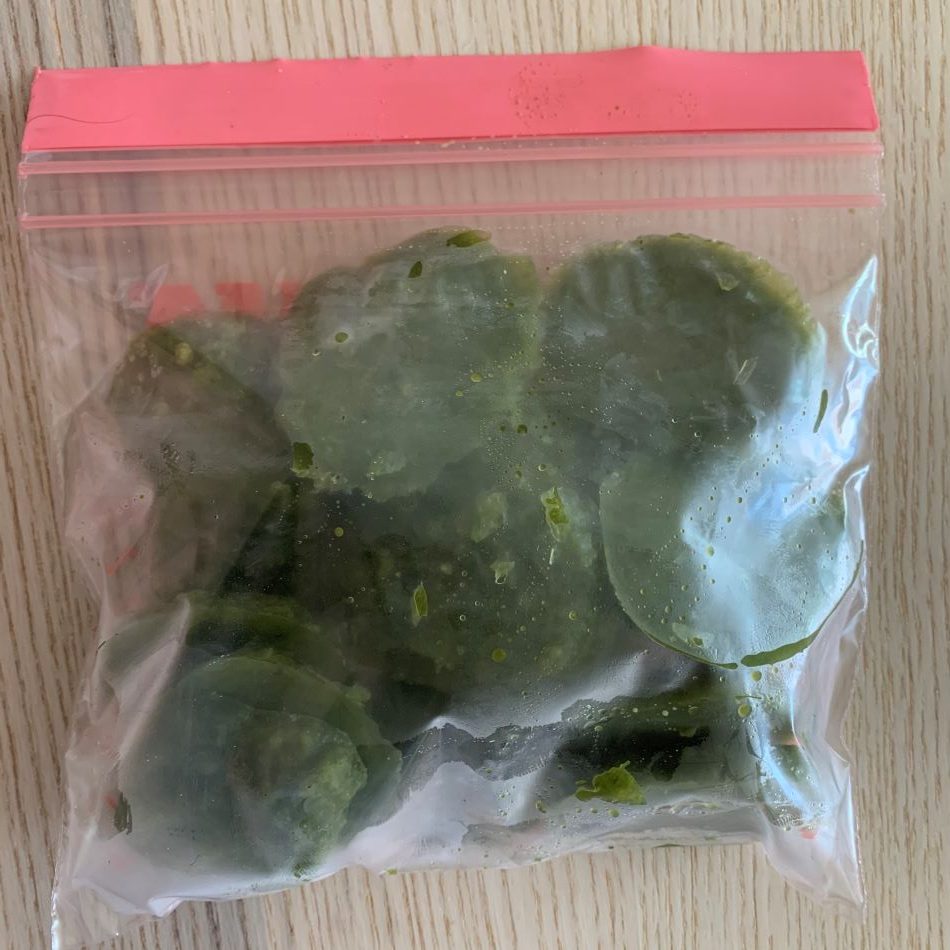How to make Cilantro (or any other leafy herbs) stay fresher longer

First of all I read a ridiculous post the other day on a certain popular food channel that cilantro and corriander leaves are not the same! Whaaaaa?! Guys, please – get this straight they are the same. So is chinese parsley. It all means the same as the leaves of plants that are grown from corriander seeds, which then flower and fruit corriander seeds.
Now that we got that straight, I know I know, some of you probably hate cilantro because you are genetically predisposed to taste soapiness from cilantro, I am sorry, but keep reading on, as you can use the same method to store any other delicate leafy herbs such as parsley, basil or mint.
If you know me, you know that if there was one ingredient I cannot survive without its cilantro! I have ZERO motivation to cook (at least Indian food, which is more than half of what I cook) if I am out of cilantro at home. I think I get that from my Aji. She would always top any of her dishes with generous amounts of this green goodness.
I am extremely particular (to say the least) about my cilantro. It has to be clean, fresh, greenest possible and crisp and dry in order to chop beautifully. Often if you try to wash it just before use, its wet and clumpy, doesn’t get chopped nicely and imparts a grassy/ soapy flavor. Not to mention, I cannot imagining storing unwashed muddy cilantro in the fridge.
With this method, you can have just the perfect cilantro at hand, ready to be chopped and garnished with at all times. I always buy fresh organic cilantro, even if it costs $5 a bunch, because its on high priority for me with Indian cooking! Depending on the quality of the cilantro, this way you can store it up to 6 weeks in the refrigerator! you read that right 🙂 So lets begin:
Scenario 1: You find the perfect beautiful, clean bunch of cilantro 🙂
- Sort the cilantro stalks to line up all the leaves, and cut the extra stems, leaving some part of the stem, as you need a good balance of the flavor from the leaves and stems when using it in cooking or to garnish

- Next wash the leaves in room temperature water with a gentle spray of water- not too cold or hot, If its hot, it will wilt, if too cold, it will get bruised and will rot faster
- If you have too much mud or dirt, simply soak in a large bowl or tub with room temp water for a few minutes and gently rinse
- Strain and let drain for 15-20 minutes. I prop the strainer up on my stove top grill so that all the water drians out well

- Next spread out on a clean kitchen towel and gently shuffle a few times to remove excess water
- Let it drain on the kitchen towel for about an hour. Make sure its not in direct sunlight or under a direct blast of AC/ cooler/ fan.
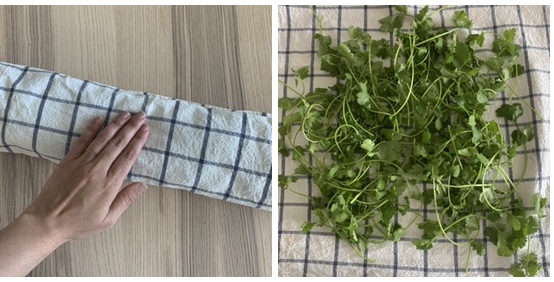
- They are ready to go in the fridge, when dry – take care not to let them dry to much, as then it will become wilted and chewy. leave any water in and it will rot in the fridge.
- roll the kitchen towel and tap out excess water
- Line an airtight plastic/ steel container with kitchen towel (paper) and add the dried cilantro leaves to it. Add a piece of paper on the top before closing the lid. If you dont do this, the cold temperature in the fridge, will cause condensation on the lid which will come in contact with your cilantro and cause it to rot.
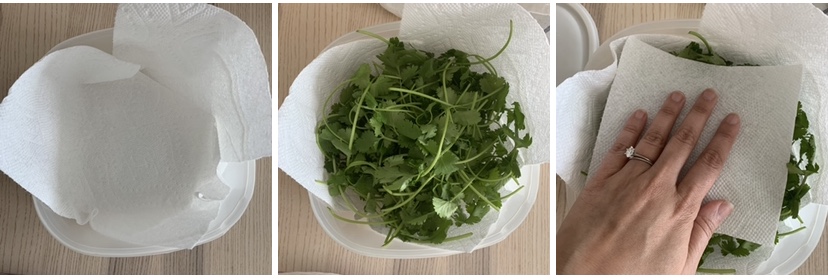
- also wash clean and dry the stems and store them in a clean steel/ plastic container. I use it in pesto, curry pastes, chutneys, soups – so many things!
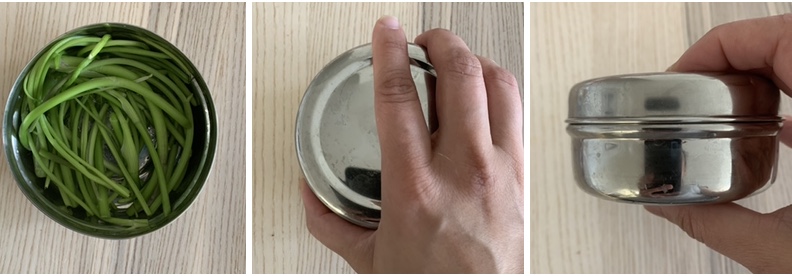
Scenario 2: You find mudy partially rotten bunch of cilantro – which I know is more realistic in India especially in monsoon
- diligently sort the dirty cilantro bunch into 3 parts –
- 1. clean, fresh, green leaves without a single rotten spot or brown leaf with clean stalks and follow the above procedure to clean and store it
- 2. Dirty rotten, non-salvageable leaves that are soggy, blackened, damaged – discard these. they will only accelerate the rotting of the good leaves and stalks
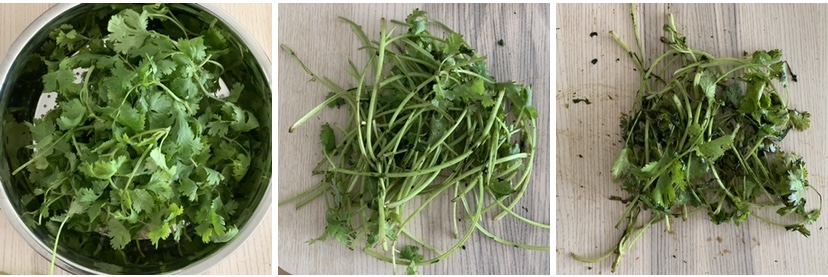
- 3. somewhat salvageable, not rotten but a little dirty, wilted, washable muddy, etc – for this soak such leaves and stalks in a big bowl of room temp water for a few minutes.
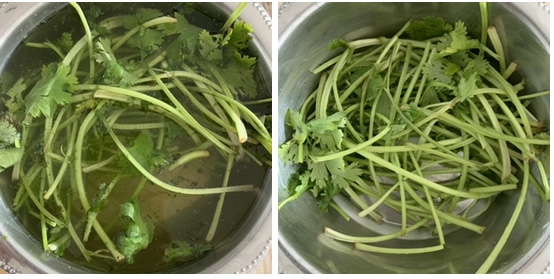
- Drain dry on a towel and use it to make chutneys. I often use these to make a cilantro-mint or cilantro-green chilli paste that I freeze. Procedure below:
Frozen green paste:
- take the cleaned dried stalks of cilantro and grind them in a mixer without adding water as much as possible.
- You can also add another herb or garlic/ ginger/ green chillies to this mixture – depending on what combination you end up using more often.
- I like to make this with green chillies (especially the ones taht are also on the evrge of yellowing, to extend their use). Also green chiili+cilantro is a good mix to use any chutneys and also curries
- Spoon the ground mixture onto a greased silicon mat and stick it in the freezer immediately (you will need to make space in the freezer before hand)

- In about half an hour-45 min, the blobs of green paste would have frozen, remove them from the mat into a ziploc bag and freeze immediately.
- This way it takes minimal space in your fridge and each blob is individually quick frozen!
